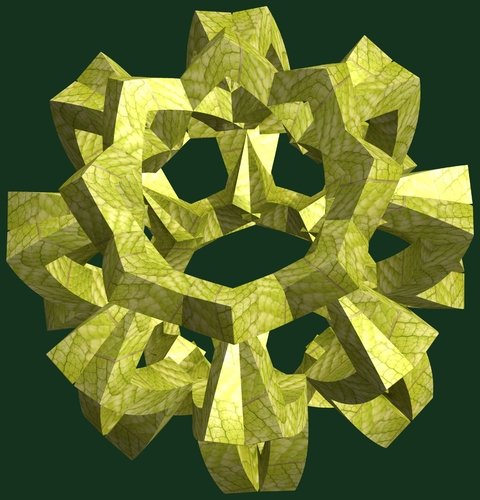Quels liens entre l’origami modulaire et les mathématiques ?
Je fais des recherches sur les liens entre mathématiques et origami modulaire et je recherche de la documentation sur comment les mathématiques peuvent aider à créer un origami modulaire, mais aussi sur les différentes manières de construire différentes représentations d’un même objet mathématique, le classement mathématique des origamis modulaires, les liens entre les techniques de pliage et les angles obtenus… et tout autre lien que je n’aurais pas mentionné.

L’origami est l’art japonais du papier plié. Mais cette pratique ancestrale et artistique a suscité un grand intérêt auprès des mathématiciens, en raison de ses propriétés algébriques et géométriques intéressantes.
Avec les mots clés « origami » et « jeux mathématiques »
Dans le contexte de l’enseignement des mathématiques, le pliage s’est d’abord développé au 19e siècle en Allemagne et au Japon. En France, il fut officiellement introduit dans l’enseignement en 1882. Aborder la géométrie sous l’angle du pliage, c’est manipuler du concret, construire et expérimenter par soi-même et pour le plaisir. Tel est le but que s’est fixé Didier Boursin, auteur de deux livres sur le sujet :
Pliages & mathématiques
Didier Boursin, ACL – les éditions du Kangourou, 2000
Notice disponible dans le SUDOC : http://www.sudoc.fr/075844850
Pour voir une page (fichier pdf)
Mathémagie des pliages
Didier Boursin, ACL – les éditions du Kangourou, 2000
Voici un livre pour les enfants et les adultes qui aiment manipuler des ciseaux et du papier en réfléchissant, et en prenant plaisir à créer des objets simples et mathémagiques. Tous les pliages proposés ici jouent avec des mathématiques et sont réalisables avec une enveloppe ou une feuille de papier.
Notice disponible dans le SUDOC : http://www.sudoc.fr/052066673
Pour voir un extrait (fichier pdf)
Dans le catalogue Sudoc, des articles scientifiques…
Voici ensuite une bibliographie de livres scientifiques élaborée à partir du catalogue collectif Sudoc (Le catalogue du Système Universitaire de Documentation est le catalogue collectif français réalisé par les bibliothèques et centres de documentation de l’enseignement supérieur et de la recherche).
Comme vous le verrez, les résultats sont essentiellement en langue anglaise ! Cliquer sur le lien pour obtenir la notice complète.
Résultat d’une recherche croisant les sujets « mathématiques » et « origami »
Origami 6. I, Mathematics : Proceedings of the Sixth International, Meeting on Origami Science, Mathematics, and Education
Koryo Miura ; Toshikazu Kawasaki, Tomohiro Tachi, Ryuhei Uehara … [et al.], American Mathematical Society, 2015
http://www.sudoc.fr/19253324X
Origami 3 : Third International Meeting of Origami Science, Mathematics, and Education
Thomas Hull, éditeur scientifique / ed. Peters, 2002
http://www.sudoc.fr/140149473
Project Origami : Activities for Exploring Mathematics
Thomas Hull, / A.K. Peters, 2006
http://www.sudoc.fr/12495913X
Modular Origami Polyhedral
Lewis Simon, Bennett Arnstein, Rona Gurkewitz, 2016,
http://www.sudoc.fr/16168842X
How to fold it : the mathematics of linkages, origami and polyhedral
Joseph O’Rourke, Cambridge University Press, 2011
http://www.sudoc.fr/16168842X
Avec les mots-clés « Origami » et « géométrie » :
Geometric exercises in paper folding
Tandalam Sundara Row. Edited and revised by Wooster Woodruff Beman and David Eugene Smith, éditeurs scientifiques, New York : Dover publications, 1966
http://www.sudoc.fr/015189155
Articles en ligne via Google Scholar
En complément, vous pouvez lire ces articles scientiques accessibles en ligne sélectionnés dans Google Scholar :
- “Origami, geometry and art” Arsalan Wares & Iwan Elstak, International Journal of Mathematical Education in Science and Technology, Volume 48, 2017 – Issue 2, pp 317-324
https://doi.org/10.1080/0020739X.2016.1238521
The purpose of this paper is to describe the mathematics that emanates from the construction of an origami box. We first construct a simple origami box from a rectangular sheet and then discuss some of the mathematical questions that arise in the context of geometry and algebra. The activity can be used as a context for illustrating how algebra and geometry, like other branches of mathematics, are interrelated.
- “Mathematical thinking and origami”, Arsalan Wares, International Journal of Mathematical Education in Science and Technology, Volume 47, 2016 – Issue 1, pp 155-163
https://doi.org/10.1080/0020739X.2015.1070211
The purpose of this paper is to describe the mathematics that emanates from the construction of an origami box. We first construct a simple origami box from a rectangular sheet and then discuss some of the mathematical questions that arise in the context of geometry and calculus.
- “Appreciation of mathematics through origami”, Arsalan Wares, International Journal of Mathematical Education in Science and Technology, Volume 44, 2013 – Issue 2, pp 277-283
https://doi.org/10.1080/0020739X.2012.678902
The purpose of this classroom note is to provide an example of how a simple origami box can be used to explore important mathematical concepts in geometry like surface area. This article describes how an origami box can be folded from a rectangular sheet of paper, then it goes on to describe how its surface area can be determined in terms of the dimensions of the rectangular sheet that was used to construct the box.
- Origami and Partial Differential Equations, Bernard Dacorogna, Paolo Marcellini and Emanuele Paolini
http://caa.epfl.ch/publications/2010-Origami_PDE.pdf
- “On the combinatorics of an origami model”, Zsolt Lengvarszky, Discrete mathematics. sd, Vol 309, Num 12, pp 4169-4173 ; Elsevier, Kidlington (United Kingdom)https://doi.org/10.1016/j.disc.2008.11.015
- We consider the problem of how the assembly process of an origami model, made up of similar pieces, can be completed given that at each step there are several choices. A result is given in the language of graphs that provides a sufficient condition under which assembly of the model will never fail.
- “Lipschitz-continuous local isometric immersions : rigid maps and origami”
https://doi.org/10.1016/j.matpur.2008.02.011 - Dacorogna, Marcellini, Paolini, Journal de mathématiques pures et appliquées. 2008, Vol 90, Num 1, pp 66-81; Elsevier, Langue English
Eurêkoi – Bibliothèque publique d’information
Publié le 01/12/2017 - CC BY-SA 3.0 FR

Les champs signalés avec une étoile (*) sont obligatoires